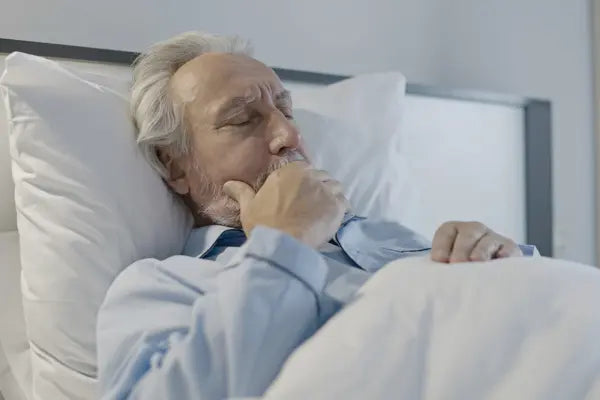
6 Causes of Shortness of Breath When Lying Down | Solutions
Share
6 Potential Causes of Shortness of Breath When Lying Down
Listen to this Article
Getting short of breath when lying down, also known as orthopnea, is a common issue experienced by individuals with various respiratory and cardiovascular conditions. It is especially noticeable when lying down straight, disrupting rest and leading to discomfort. This article explores six potential causes of shortness of breath when lying down, along with solutions to manage this condition and improve overall quality of life.
Table of Contents
- Overview
- 1. Congestive Heart Failure (CHF)
- 2. Obstructive Sleep Apnea (OSA)
- 3. Asthma
- 4. Chronic Obstructive Pulmonary Disease (COPD)
- 5. Anxiety
- 6. Gastroesophageal Reflux Disease (GERD)
- Solutions & Treatments
Overview
Shortness of breath when lying down is a symptom known as orthopnea, which can be caused by various underlying health conditions, primarily affecting the heart and lungs. People with conditions like CHF, asthma, and COPD may experience worsened symptoms when lying flat due to fluid buildup, airway obstruction, or respiratory distress. Understanding these causes can help determine the right course of treatment to alleviate discomfort.

1. Congestive Heart Failure (CHF)
Congestive heart failure (CHF) occurs when the heart cannot pump blood effectively, leading to fluid accumulation in the lungs. This fluid buildup can make breathing difficult, especially when lying flat, as gravity causes the fluid to spread across the lungs.
Solution:
To manage CHF, medications such as diuretics are used to remove excess fluid from the body. Sleeping with the head elevated or using additional pillows can reduce the pressure on the lungs and make breathing easier. Regular check-ups with a healthcare provider are crucial for monitoring heart function and getting the right treatment to manage your condition.
2. Obstructive Sleep Apnea (OSA)
Obstructive sleep apnea (OSA) occurs when the upper airway becomes blocked during sleep, causing temporary pauses in breathing. This blockage is more likely to happen when lying down, as the muscles in the throat relax and collapse.
Solution:
The primary treatment for OSA is the use of a CPAP (Continuous Positive Airway Pressure) machine, which helps keep the airway open. In some cases, lifestyle changes such as weight loss, avoiding alcohol, and sleeping on the side can also reduce symptoms. For some people with OSA, lying on their side (right side or left side) or lying on the belly can reduce the episodes of apnea.

3. Asthma
A chronic inflammatory disease, asthma causes the airways to narrow and swell, making it difficult to breathe. When lying down, gravity can cause mucus to accumulate in the lungs, worsening asthma symptoms and leading to shortness of breath.
Solution:
Using inhalers (such as corticosteroids and bronchodilators) can help reduce airway inflammation and make breathing easier. Sleeping with the head elevated and avoiding asthma triggers like allergens can help reduce symptoms. For some people the symptoms of asthma are more active at night time. You may use your inhalers in evening to help. Also make sure that the bedding, pillows and curtains in your bed room are not triggering your allergies and asthma.
4. Chronic Obstructive Pulmonary Disease (COPD)
COPD is a group of lung diseases that cause airflow obstruction and breathing difficulties. Individuals with COPD often experience shortness of breath due to poor exchange of Oxygen and Carbon dioxide in the lungs and narrowing of the air tubes. For some people the breathing can get worse when lying down, specially if you are overweight.
Solution:
COPD management includes medications like bronchodilators and corticosteroids to reduce inflammation and open airways. Supplemental oxygen may also be used if oxygen levels drop. Sleeping with the head elevated can help reduce symptoms, and practicing breathing exercises such as pursed-lip breathing can also be beneficial.
5. Anxiety
Anxiety can lead to feelings of breathlessness, especially when lying down. When anxious, the body goes into "fight or flight" mode, causing the respiratory rate to increase, which can lead to difficulty breathing.
Solution:
Managing anxiety through relaxation techniques such as deep breathing, meditation, or cognitive-behavioral therapy (CBT) can help reduce breathlessness. If anxiety continues to be a major issue, medications like SSRIs or benzodiazepines may be prescribed to help manage symptoms.
6. Gastroesophageal Reflux Disease (GERD)
GERD is a condition where stomach acid flows back into the esophagus, causing heartburn and irritation. This acid can reach the airways when lying down, making it harder to breathe and increasing the sensation of breathlessness.
Solution:
Treatment for GERD includes medications like proton pump inhibitors (PPIs) and H2 blockers to reduce stomach acid production. Sleeping with the head elevated and avoiding large meals before bedtime can also help alleviate GERD symptoms. Also avoid use of caffeine and nicotine 6 to 8 hours before sleep time. These chemicals relax the muscles in the food pipe that stops the acid from coming up.
Solutions & Treatments
Managing shortness of breath when lying down requires a multi-faceted approach. Depending on the underlying cause, treatment may include medications, lifestyle changes, and using adaptive equipment such as CPAP machines or supplemental oxygen. Regular follow-up with a healthcare provider is essential for monitoring and managing the condition.
Summary Points
- Shortness of breath when lying down (orthopnea) can be caused by conditions like CHF, asthma, COPD, and anxiety.
- Elevating the head and using CPAP or oxygen therapy can help alleviate symptoms.
- Medications and lifestyle changes can help manage underlying conditions and reduce breathlessness.
- Seek medical advice and consult your doctor to make sure you have an accurate diagnosis of your condition and you are getting the right treatment for it.
This article is for general health awareness. Please consult your doctor and medical professionals for more information, personlized care, diagnosis and treatment.
